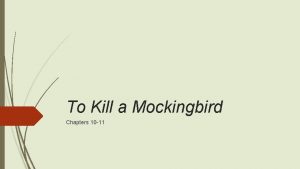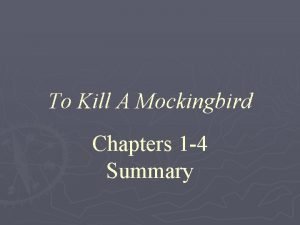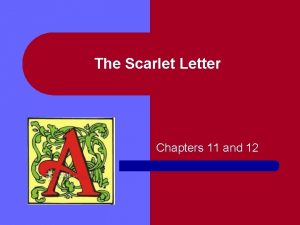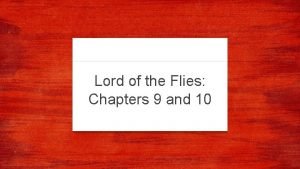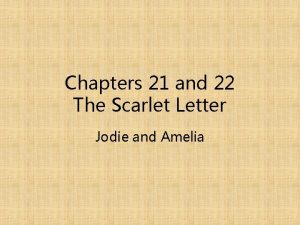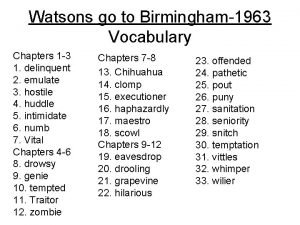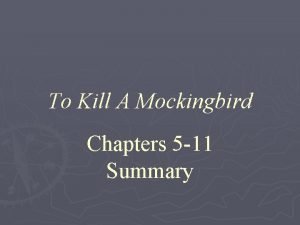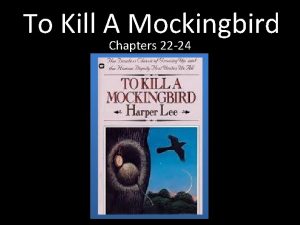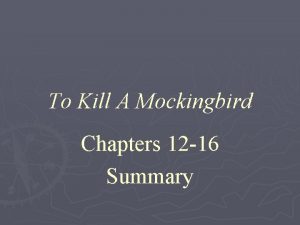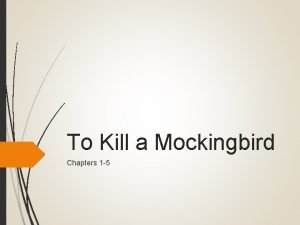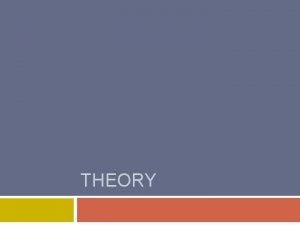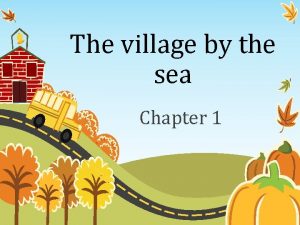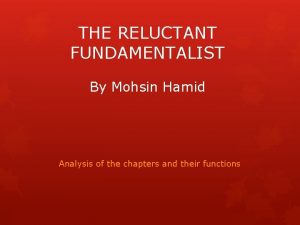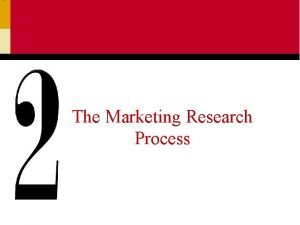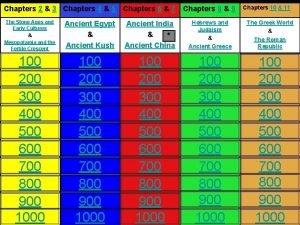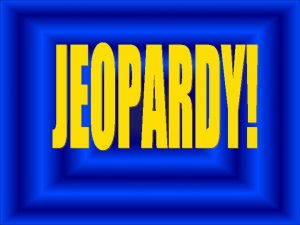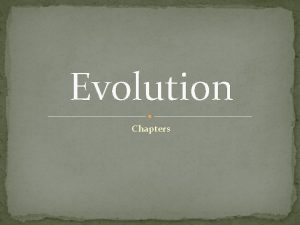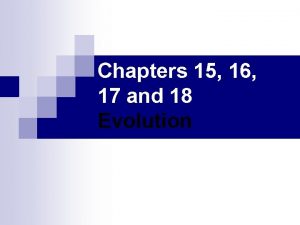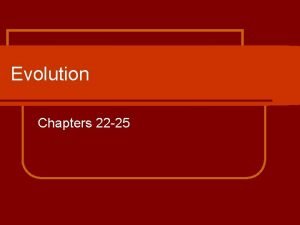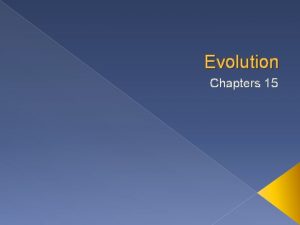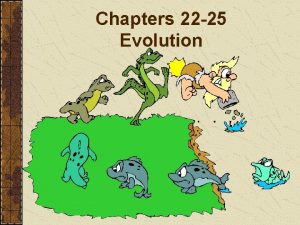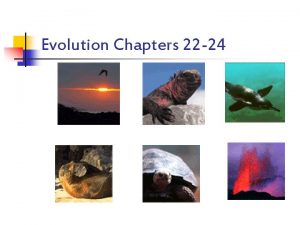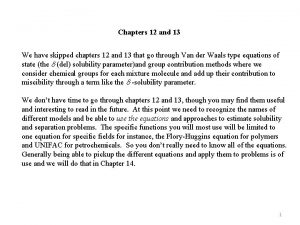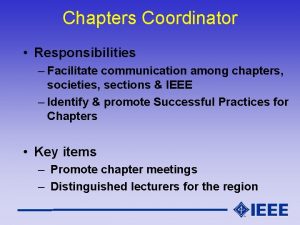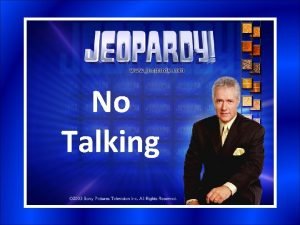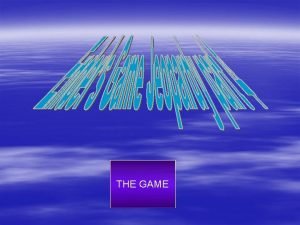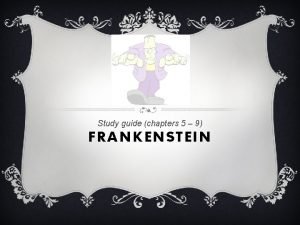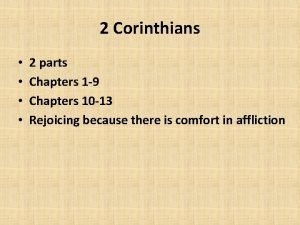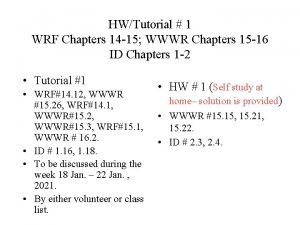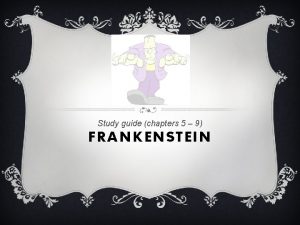Chapters 14 15 and 16 Evolution Evolution The










































































- Slides: 74

Chapters 14, 15, and 16 Evolution

Evolution The definition of Evolution is: Change over time. Biological Evolution is: Change in allele frequency in population over time Process by which modern organisms have descended from ancient organisms (slow change over long time) • Even relatively quick evolution takes hundreds of thousands of years.

Age of the Earth We now know Earth is approximately 4. 5 billion years old. Activity Time: Organize the strips of matter chronologically from oldest to most recent.

The evolution model includes the scientific evidence and the related inferences suggesting that: I. The universe and the solar system emerged by naturalistic processes. II. Life emerged from nonlife by naturalistic processes. III. All present kinds emerged from simpler earlier kinds, so that single-celled organisms evolved into invertebrates, then amphibians, then reptiles, then mammals, then primates, including man. IV. Mutation and natural selection have brought about the emergence of present complex kinds from a simple primordial organism. V. Man and apes emerged from a common ancestor. VI. The earth's geologic features were fashioned largely by slow, gradual processes, with infrequent catastrophic events restricted to a local scale (uniformitarianism). VII. The inception of the earth and then of life must have occurred several billion years ago.

James Hutton In the late 1700’s, James Hutton (a geologist) proposed that rocks, mountains, and valleys have been changed by water, wind, temperature, volcanoes, and other natural forces. He theorized that Earth was much older than a few thousand years, which didn’t set well in the traditional timeframe of Creationism.

Geologists Charles Lyell (early 1800’s) – agreed with Hutton and said that scientists must always explain past events in terms of observable, PRESENT events and processes (uniformitarianism). Darwin used the work of Hutton and Lyell as a basis for his theories of slow change over time. Darwin’s work was a biological duplicate of Hutton and Lyell’s works in geology.



Geologists study Earth’s rocks Fossils are preserved remains of ancient organisms Found in Sedimentary rock: layers of sand, silt, and clay in streams, lakes, rivers, and seas form rock that may have trapped living organisms

Fossils can be direct evidence (ex. Bones, hair, feathers) or indirect evidence (ex. Molds, footprints)


Fossil Hominid Skulls

Fossil Evidence Fossil record – Shows change over time. Some timeframes are missing, but will show change of climate and geography. Ex: Shark teeth in Utah • How can this be?

Geologists study Earth’s rocks As fossils are found that don’t resemble organisms today, evidence increases that Earth has changed and that organisms have changed with it. Biologists and geologists date Earth’s past with the help of rocks.

Geological Time Scale RELATIVE DATING Technique used to determine age of fossils relative to other fossils in different layers of rock. This technique is VERY approximate.


Geological Time Scale ABSOLUTE (RADIOACTIVE) DATING Using radioactive elements in rock that decay at a steady rate to determine age. Decay measured in terms of HALF-LIFE.

Radioactive Decay During radioactive decay, the atoms of one element break down to form something else. 6 protons 4 neutrons Lose a proton 5 protons 4 neutrons

Rocks contain radioactive elements, each having a different half-life. Half-life – time required for half the radioactive atoms in a sample to decay End of half life half of remaining atoms have decayed EXAMPLES: Uranium-238 Lead-206 HL = 4. 5 B yrs Potassium-40 Argon-40 HL = 1. 3 B yrs Carbon-14 Nitrogen-14 HL = 5770 yrs

Scientists often date rocks using Potassium-40. This element decays to form the stable element Argon-40. It has a half life of 1. 3 billion years This is used in the oldest rocks on earth. K-40 Formed K-40 Ar-40 1. 3 billion 2. 6 billion


Uranium and Potassium are useful for dating rocks Carbon-14 is useful for dating things that were once alive such as wood, natural fiber, or cloth C-14 is in the atmosphere; living things take it in their cells. After the organism dies, it doesn’t take in any more C-14. We can then compare the amounts of C-14 to N-14, knowing its half-life, to determine the age of the sample

PRACTICE 1. 20 g C → 10 g C → 5 g C How long did this take? 2. What happened to the other 15 g of C? 3. 3. 9 Billion years have passed and there is only 10 g of Potassium left. What was the original amount before radioactive decay started happening?


Jean Baptiste de Lamarck (1744 -1829) He also recognized that organisms were adapted to their environments and that they change He relied on three ideas: 1. A desire to change (innate drive for perfection) 2. Use and disuse (Giraffe’s necks and vestigial organs) 3. Inheritance of acquired characteristics


Darwin’s Dilemma Set sail around the world in 1831 on HMS Beagle on a 5 year voyage He had prior knowledge of geology (Lyell was a good friend) and agriculture that helped influence the development of his theory Anchored all along the way and took samples from each place

Voyage of the Beagle


Darwin’s Dilemma He collected and studied beetles from Brazil, birds from Chile, and iguanas, tortoises, and finches from the Galápagos Islands He noticed similarities between mainland (Ecuador) and Galapagos finches Later, he noticed differences in beak size among finches from different islands in the Galapagos




Darwin’s Dilemma Thomas Malthus – wrote paper on population growth in Great Britain Population grows exponentially Limiting factors on growth (carrying capacity) • Food • Area • Resources

Darwin’s Dilemma Darwin applied Malthus’, Hutton’s, and Lyell’s work to species’ ability to change, and called the mechanism Natural Selection Nat. Sel. : Process by which organisms with favorable variations survive and produce more offspring than less welladapted organisms He was sure Nat. Sel. was true, but he feared public ridicule. So, he kept his ideas to himself

Darwin’s Dilemma Alfred Russel Wallace (1823 -1913), working independently, came to the same conclusions as Darwin He sent a manuscript to Darwin, basically for proofreading “I never saw a more striking coincidence… so all my originality, whatever it may amount to, will be smashed. ” – Charles Darwin Letter to Charles Lyell, June 18, 1858 Darwin quickly abridged and published his work “On the Origin of Species”

Evidence in Living Organisms Comparative embryology: These anatomical similarities indicate similar genetics are at work Become more dissimilar as they grow • Cell specialization and differentiation Common ancestor? Ernst Haeckel “fudged” his data • Big no-no; hurt evolutionary theory for a long time

Evidence in Living Organisms

Evidence in Living Organisms Comparative anatomy: Homologous Structures – structures that are similar in anatomy, but may serve very different functions. • Ex: cat, whale, and human forearm

Homologous Structures Flying Swimming Running Grasping

Evidence in Living Organisms Comparative Anatomy (cont. ): Analogous Structures – structures that serve similar functions, but have evolved independently of each other

Not homologous; analogous Not homologous; not analogous Homologou s; analogous

Evidence in Living Organisms. Comparative Anatomy (cont. ): Vestigial organs – organs that have little or no purpose in the organism; may become smaller or even disappear • Ex: Tailbone or appendix in humans • Ex: Tiny leg bones in snakes (boas and pythons) thought to come from 4 legged ancestor

Evidence in Living Organisms Comparative biochemistry and molecular biology: All cells have DNA, RNA, ribosomes, the same 20 amino acids and use ATP as an energy carrier. Similarities in chemical compounds such as DNA and RNA

Evidence in Living Organisms Cytochrome c is a highly conserved respiratory protein containing 104 amino acids in humans

What Homologies tell us… Similarities in structure and chemistry provide powerful evidence that all living things evolved from a common ancestor Darwin Concluded: Living organisms evolved through gradual modifications of earlier forms descent with modification

What Similarities tell us… Two types of evolution can account for homologous AND analogous structures Divergent evolution Convergent evolution

What Similarities tell us… 1. Divergent evolution – two species evolve from a common ancestor (speciation) They share similarities in anatomy, biochemistry, and embryology due to common ancestry Explains homologous structures

What Similarities tell us… 2. Convergent – two species apparently becoming more similar Two species have adapted in similar ways to similar environmental conditions NOT due to common ancestry Explains analogous structures

Convergent Evolution Ocotillo from California and allauidi from Madagascar have evolved similar mechanisms for protecting themselves

Diversity of Life Fitness: Physical traits and behaviors that enable organisms to survive and reproduce in their environment arises from adaptation. Adaptation allows species to be better suited to their environment and therefore can survive and reproduce.

4 Driving Forces behind Evol. 1. Mutation Any change in the original DNA ONLY source of variation in a population!! 2. Gene Flow Movement of genes either in or out of a population Migration – Immigration and Emigration

4 Driving Forces behind Evol. 3. Genetic Drift Change in the allele frequency in a population by chance alone. • Bottleneck Effect • Founder Effect

4 Driving Forces behind Evol. 3. Genetic Drift Bottleneck Effect: population undergoes a high mortality rate; genetic variation decreases dramatically Ex: Cheetahs

Genetic Drift: Bottleneck Effect

4 Driving Forces behind Evol. 3. Genetic Drift Founder Effect: few individuals leave a large population to start their own; gene pool is very limited Ex: polydactyly in PA Amish

Genetic Drift: Founder Effect

Genetic Drift: Founder Effect

4 Driving Forces behind Evol. 4. Selection Natural – differential success in the reproduction of different phenotypes resulting from the interaction of organisms with their environment • Nature does the selecting

4 Driving Forces behind Evol. 4. Selection (Natural) Resistance – overuse of insecticides and antibiotics have bred resistant species of bugs and germs

4 Driving Forces behind Evol. 4. Selection Artificial – breeding of domesticated plants and animals • Humans intentionally do the selecting • Cabbage, cauliflower, Brussels sprouts, kale, kohlrabi and broccoli have a common ancestor in one species of wild mustard

4 Driving Forces behind Evol. Problems with artificial selection – not enough genetic variation

4 Driving Forces behind Evol. 4. Selection (Sexual) Intrasexual selection – selection within the same sex (competition, usually between males s Competition, usually between males s Exaggerated anatomy Bighorn Sheep Rocky Mountain Elk Five-horned Rhinoceros Beetles Stagbeetles

4 Driving Forces behind Evol. 4. Selection (Sexual) Intersexual selection – one sex selects mate based on phenotypes Exaggerated anatomy

Evolutionary Time Scales Evolution can take a long time or can occur relatively quickly Gradualism Punctuated Equilibrium

Evolutionary Time Scales Gradualism – big evolutionary changes are the result of many small ones over a long period of time

Evolutionary Time Scales Punctuated Equilibrium – speciation occurs fairly rapidly then remain constant

Selection can influence populations in three major ways: Directional Sel. Stabilizing Sel. Disruptive (diversifying) Sel.

Directional Selection Environment selects against one phenotypic extreme, allowing the other to become more prevalent

Disruptive Selection Environment selects against intermediate phenotype, allowing both extremes to become more prevalent

Stabilizing Selection Environment selects against two extreme phenotypes, allowing the intermediates to become more prevalent


Key Points 1. Natural selection does not cause genetic changes in individuals. 2. Natural selection acts on individuals; evolution occurs in populations. 3. Evolution is a change in the allele frequencies of a population, owing to unequal success at reproduction among organisms bearing different alleles. 4. Evolutionary changes are not “good” nor “progressive” in any absolute sense.

Evolutionary Theory Foundation on which the rest of the biological science is built. Collection of carefully reasoned and tested hypotheses about how evolutionary change occurs.
 Hát kết hợp bộ gõ cơ thể
Hát kết hợp bộ gõ cơ thể Frameset trong html5
Frameset trong html5 Bổ thể
Bổ thể Tỉ lệ cơ thể trẻ em
Tỉ lệ cơ thể trẻ em Chó sói
Chó sói Tư thế worm breton
Tư thế worm breton Hát lên người ơi alleluia
Hát lên người ơi alleluia Các môn thể thao bắt đầu bằng tiếng chạy
Các môn thể thao bắt đầu bằng tiếng chạy Thế nào là hệ số cao nhất
Thế nào là hệ số cao nhất Các châu lục và đại dương trên thế giới
Các châu lục và đại dương trên thế giới Công thức tiính động năng
Công thức tiính động năng Trời xanh đây là của chúng ta thể thơ
Trời xanh đây là của chúng ta thể thơ Mật thư tọa độ 5x5
Mật thư tọa độ 5x5 101012 bằng
101012 bằng Phản ứng thế ankan
Phản ứng thế ankan Các châu lục và đại dương trên thế giới
Các châu lục và đại dương trên thế giới Thể thơ truyền thống
Thể thơ truyền thống Quá trình desamine hóa có thể tạo ra
Quá trình desamine hóa có thể tạo ra Một số thể thơ truyền thống
Một số thể thơ truyền thống Cái miệng nó xinh thế chỉ nói điều hay thôi
Cái miệng nó xinh thế chỉ nói điều hay thôi Vẽ hình chiếu vuông góc của vật thể sau
Vẽ hình chiếu vuông góc của vật thể sau Biện pháp chống mỏi cơ
Biện pháp chống mỏi cơ đặc điểm cơ thể của người tối cổ
đặc điểm cơ thể của người tối cổ Thế nào là giọng cùng tên?
Thế nào là giọng cùng tên? Vẽ hình chiếu đứng bằng cạnh của vật thể
Vẽ hình chiếu đứng bằng cạnh của vật thể Phối cảnh
Phối cảnh Thẻ vin
Thẻ vin đại từ thay thế
đại từ thay thế điện thế nghỉ
điện thế nghỉ Tư thế ngồi viết
Tư thế ngồi viết Diễn thế sinh thái là
Diễn thế sinh thái là Dạng đột biến một nhiễm là
Dạng đột biến một nhiễm là Các số nguyên tố là gì
Các số nguyên tố là gì Tư thế ngồi viết
Tư thế ngồi viết Lời thề hippocrates
Lời thề hippocrates Thiếu nhi thế giới liên hoan
Thiếu nhi thế giới liên hoan ưu thế lai là gì
ưu thế lai là gì Hổ sinh sản vào mùa nào
Hổ sinh sản vào mùa nào Khi nào hổ mẹ dạy hổ con săn mồi
Khi nào hổ mẹ dạy hổ con săn mồi Sơ đồ cơ thể người
Sơ đồ cơ thể người Từ ngữ thể hiện lòng nhân hậu
Từ ngữ thể hiện lòng nhân hậu Thế nào là mạng điện lắp đặt kiểu nổi
Thế nào là mạng điện lắp đặt kiểu nổi To kill a mockingbird 10-11 summary
To kill a mockingbird 10-11 summary Chapter 1 to kill a mockingbird short summary
Chapter 1 to kill a mockingbird short summary Summary of noughts and crosses
Summary of noughts and crosses Chapter 3 and 4 the great gatsby
Chapter 3 and 4 the great gatsby Jekyll and hyde chapter 3
Jekyll and hyde chapter 3 Chapter 18 charlie and the chocolate factory
Chapter 18 charlie and the chocolate factory Chapter 10 and 11 to kill a mockingbird
Chapter 10 and 11 to kill a mockingbird Scarlet letter chapter 12 summary
Scarlet letter chapter 12 summary Pride and prejudice volume 3
Pride and prejudice volume 3 Summary of chapter 9 lotf
Summary of chapter 9 lotf Chapters 21 and 22 scarlet letter
Chapters 21 and 22 scarlet letter The watsons go to birmingham vocabulary
The watsons go to birmingham vocabulary Tuesday with morrie summary
Tuesday with morrie summary Catcher in the rye quotes
Catcher in the rye quotes Chapters 22-23 to kill a mockingbird
Chapters 22-23 to kill a mockingbird To kill a mockingbird quiz chapters 1 11
To kill a mockingbird quiz chapters 1 11 Tkam chapter 9
Tkam chapter 9 To kill a mockingbird chapter 4
To kill a mockingbird chapter 4 Summary of chapters 28-31 to kill a mockingbird
Summary of chapters 28-31 to kill a mockingbird Chapter 27 questions to kill a mockingbird
Chapter 27 questions to kill a mockingbird What chapter does bob ewell spit on atticus
What chapter does bob ewell spit on atticus To kill a mockingbird ch 12
To kill a mockingbird ch 12 Characters in to kill a mockingbird chapter 1-3
Characters in to kill a mockingbird chapter 1-3 Infallible definition to kill a mockingbird
Infallible definition to kill a mockingbird Summary of chapter 4-6 things fall apart
Summary of chapter 4-6 things fall apart Chapter 17 summary of things fall apart
Chapter 17 summary of things fall apart Things fall apart chapter 16
Things fall apart chapter 16 Portia nelson autobiography in five short chapters
Portia nelson autobiography in five short chapters The village by the sea characters
The village by the sea characters The reluctant fundamentalist chapter 1 summary
The reluctant fundamentalist chapter 1 summary The reluctant fundamentalist chapter summary
The reluctant fundamentalist chapter summary Marketing research process steps with example
Marketing research process steps with example Hunger games chapter 6 questions and answers
Hunger games chapter 6 questions and answers










































